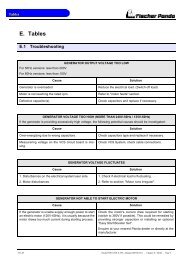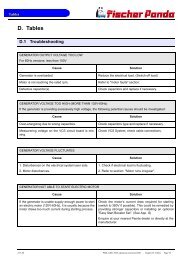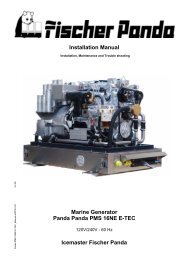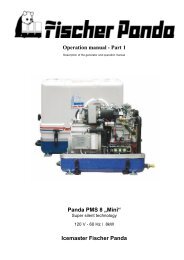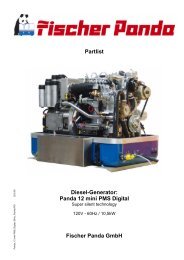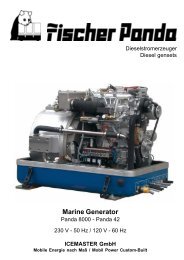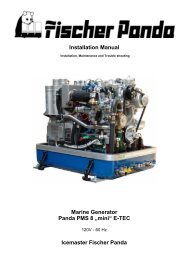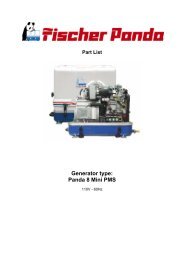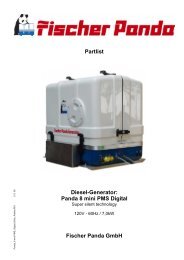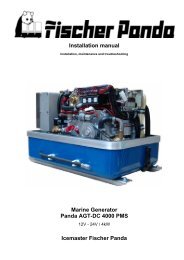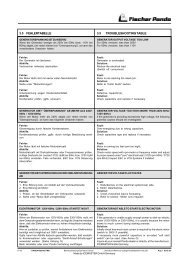Marine Generator Panda AGT-DC 4000 PMS Icemaster Fischer ...
Marine Generator Panda AGT-DC 4000 PMS Icemaster Fischer ...
Marine Generator Panda AGT-DC 4000 PMS Icemaster Fischer ...
Create successful ePaper yourself
Turn your PDF publications into a flip-book with our unique Google optimized e-Paper software.
Operation manual<br />
Description of the generator and operation manual<br />
<strong>Marine</strong> <strong>Generator</strong><br />
<strong>Panda</strong> <strong>AGT</strong>-<strong>DC</strong> <strong>4000</strong> <strong>PMS</strong><br />
Super silent technology<br />
12V - 280A / 4kW<br />
<strong>Icemaster</strong> <strong>Fischer</strong> <strong>Panda</strong>
<strong>Fischer</strong> <strong>Panda</strong><br />
25 20 10 10 10<br />
since 1977<br />
<strong>Icemaster</strong> GmbH<br />
since 1978<br />
<strong>Fischer</strong> <strong>Marine</strong><br />
<strong>Generator</strong>s<br />
since 1988<br />
Conclusion <strong>Fischer</strong> -<br />
<strong>Icemaster</strong> GmbH<br />
FISCHER GENERATORS have been manufactured since 1978 and are a well-known brand for first class diesel generators<br />
with especially effective sound-insulation.<br />
<strong>Fischer</strong> has been one of the leading manufacturers in respect of quality and know-how during this period.<br />
FISCHER, as the worldwide manufacturer of modern marine diesel generators, developed the Sailor-Silent series for<br />
example and produced a GFK sound-insulated capsule as early as 1979 and the basis for new generator technology.<br />
The companies <strong>Fischer</strong> and <strong>Icemaster</strong> amalgamated under the direction of <strong>Icemaster</strong> in 1988, in order to concentrate<br />
on the development of new products. Production was moved to Paderborn.<br />
The amalgamation of the two qualified companies led to the development of a complete new programme within a short<br />
space of time. The aggregates developed at that time set new technological standards worldwide.<br />
The aggregates became more efficient and powerful than other aggregates in the same nominal performance range,<br />
because of the improved cooling. <strong>Panda</strong> generator demonstrated its superiority in several tests by renowned institutes<br />
and magazines during the past years. The patented VCS (voltage Control System) means it can meet all demands<br />
including motor speed. The start-booster (ASB) means <strong>Panda</strong> generators meet the highest demands in respect of<br />
voltage stability and starting values A <strong>Panda</strong> generator, with the same drive motor, produces 15% more effective output<br />
than the majority of conventional generators. This superiority in efficiency also ensures a fuel saving to the same extent.<br />
The 100% water-cooled <strong>Panda</strong> Aggregate are currently manufactured in the performance range from 2 to 100 kW in<br />
various versions. Fast running motors are preferred for performances up to approx 30 kW (Nominal speed 3000 rpm).<br />
The heavier slow runners are preferred for the higher range. The fast running aggregates have proved themselves<br />
many times for many uses, that they meet the demands in quality of yachts and vehicles, and offer space and weight<br />
saving of 50% compared to slow running generators.<br />
In addition to the <strong>Panda</strong> series, <strong>Icemaster</strong> also supply the super compact high-tech sound-insulated battery charging<br />
aggregate from the <strong>DC</strong>/AC <strong>Panda</strong> <strong>AGT</strong> series, which is a very interesting solution for the production of mobile power.<br />
The new HTG-alternators ensure that a charging rate of 285 amps is achieved that was scarcely thought possible for<br />
this compact construction. This alternator replaces a separate shipboard generators (constant 230 volts AC with up to<br />
3500 kW from the main machine)<br />
ICEMASTER GmbH, 33104 Paderborn, reserves all rights regarding text and graphics. Details are given to the best of our knowledge. No liability is accepted for correctness.<br />
Technical modifications for improving the product without previous notice may be undertaken without notice. Before installation, it must be ensured that the Pictures,<br />
diagrams and related material are applicable to the aggregate supplied. Enquiries must be made in case o doubt.<br />
ii<br />
since 1988<br />
100 % water cooled<br />
<strong>Panda</strong> generators<br />
since 1988<br />
<strong>Panda</strong> Vehicle<br />
<strong>Generator</strong>s
CALIFORNIA<br />
Proposition 65 Warning<br />
Diesel engine exhaust and some of its constituents<br />
are known to the State of California to cause cancer,<br />
birth defects, and other reproductive harm.<br />
Attention, Important Directions regarding Operation!<br />
1. The installation certificate must be completed when taken into use, and certified by a signature.<br />
2. The installation certificate must be despatched within two weeks of use to ICEMASTER.<br />
3. The official guaranty confirmation will be completed by ICEMASTER after receipt and sent to the customer.<br />
4. A guaranty must be shown to make any claims.<br />
Claims against the guaranty will not be accepted of the above said instructions are not, or only partially, carried out.<br />
Manufacturer declaration in terms of the machine guideline 98/37/EG .<br />
The generator is in such a way developed that all assembly groups correspond to the CE guidelines. If machine guideline<br />
98/37/EG is applicable, then it is forbidden to bring the generator into operation until it has been determined<br />
that the system into which the generator is to be installed in also corresponds to the regulations of the machine guideline<br />
98/37/EG. This concerns among other things the exhaust system, cooling system and the electrical installation.<br />
The evaluation of the "protection against contact" can only be accomplished in connection with the respective<br />
system. Likewise among other things responsibility for correct electrical connections, a safe ground wire connection,<br />
foreign body and humidity protection, protection against humidity due to excessive condensation as well as the overheating<br />
through appropriate and inappropriate use in its installed state on the respective machine lies within the<br />
responsibility of those who undertake installation of the generator in the system.<br />
Use the advantages of the customer registration:<br />
• Thus you receive to extended product informations, which are sometimes safety-relevant<br />
• you receive, if necessarily free Upgrades<br />
Far advantages:<br />
By your full information <strong>Fischer</strong> <strong>Panda</strong> technicians can give you fast assistance, since 90% of the disturbances result<br />
from errors in the periphery.<br />
Problems due to errors in the installation can be recognized in the apron.<br />
Technical Support per Internet: info@fischerpanda.de<br />
iii
Safety Instructions<br />
The electrical Installations may only be carried out be trained and<br />
tested personnel!<br />
The generator may not be taken into use with the cover removed.<br />
The rotating parts (belt-pulley, belts, etc) must be so covered and protected do that there is no danger to life and<br />
body!<br />
If a sound insulation covering must be produced at the place of installation, then well-placed signs must show that<br />
the generator can only be switched on with a closed capsule.<br />
All servicing-, maintenance or repair work may only carried out, when the motor is not running.<br />
Electrical voltages above 48 volts ( battery chargers greater than 36 volts) are always dangerous to life). The rules of<br />
the respective regional authority must be adhered to. Only an electrician may carry out installation of the electrical<br />
connections for safety reasons.<br />
General safety references for the enterprise of a <strong>AGT</strong> generator.<br />
With all energized systems, with which the current is more than 50 Ampère, special safety precautions must be<br />
made, in order to protect the environment of the components against fire.<br />
It is to be ensured absolutely that at the battery a main switch in well accessible place is accommodated, so that with<br />
danger of the main switches can be separated immediately. The main switch must be however also directly at the<br />
battery installed. If this place is not well accessible, a power relay must be used instead of the main switch which can<br />
be served manually, which can be served then if necessary from different places. The switches for the power relay<br />
are to mark accordingly as main switches <strong>DC</strong> battery "with danger switch off!".<br />
Cooling of the diode block.<br />
The diode block is cooled with fresh water. A normal cooling of the diode block is therefore only possible, as long as<br />
the cooling water supply of the generator functions duly. The cooling water supply of the generator must be so furnished<br />
therefore that by a wide dirt deflector it is guaranteed that from outside no dirt can be sucked in into the line<br />
system. If this is not attainable, the supply must be secured by a flow switch or a negative pressure switch. The<br />
generator must be switched off, if the cooling water supply is impair.<br />
The temperature safety device on the diode block can be regarded only as additional safety device. The temperature<br />
rise at the diodes is so fast that the diodes can be damaged during a unique interruption of the cooling water supply.<br />
A safe protection from damage of the diodes is not possible by the temperature monitoring on the diode radiator box.<br />
Thus this can take place only by means of an appropriate external monitoring of the cooling system.<br />
ATTENTION!<br />
Do not connect the minus pole of the starter battery to the ground of the boat because of galvanic reason.<br />
Warning!<br />
Never start the generator with the battery disconnected, the diodes will be damaged!<br />
CAUTION!<br />
Contact of the electrical contacts may be DANGER TO LIVE!<br />
iv
CAUTION!<br />
The <strong>AGT</strong>-generator is not allowed to be connected to an inverter (without batteries)!<br />
The Inverter generates voltage peaks, which can destroy the rectifier diodes of the generator!<br />
A battery must always be connected to the inverter as a capacity!<br />
Recommended capacity at 12V ≥ 240Ah at 24V ≥ 120Ah<br />
The screws at the electric rectifier may be pulled tight only with a torque wrench. Torque 4Nm.<br />
The battery cable must be secured at the generator and at the batteries with appropriate safety devices.<br />
The generator is also include into the CO 2 - fire-extinguishing system.<br />
v
Measures to the fire protection.<br />
All construction units in the environment of energized parts, which carry more than 50 Amp., must be fire protectionmoderately<br />
secured.<br />
All junction points at the energized parts must be examined regularly on heating up (infrared thermometers).<br />
Safety Instrictions for the Handling with Batteries<br />
These instructions must be noticed additionally to the instructions of the battery manufacturer:<br />
• If the batteries are working, someone should be in your near area to help you in a case of emergency.<br />
• Water and soap must be hold ready if battery acid corrode your skin.<br />
• Wear eye protection and protective clothing. During working with the batteries don´t touch the eyes.<br />
• If you got a acid splash on your skin or clothing grow it with much water and soap out.<br />
• If you got acid in your eyes rinse them immediately with clear water until no cauterization is noticeable. Visit immediate<br />
a doctor.<br />
• Don´t smoke in the near of the batteries. Avoid naked flames or open fires. In the area of batteries exists danger<br />
of explosions.<br />
• Pay attention that no tools fall on the battery poles, if necessary cover them.<br />
• During the installation don´t wear a wrist watch or arm jewels, you can create under these circumstances a battery<br />
short-circuit. Burning of the skin could be the result.<br />
• Protect every battery contact against unintentional touch.<br />
• Use only cyclical profoundly dischargeable batteries. Starter batteries are not appropriate. Lead-gel batteries are<br />
commended. They are maintenance-free, profoundly dischargeable and not produce gas.<br />
• Do not charge a frozen battery.<br />
• Avoid a batterie short-curcuit.<br />
• Take care of a good ventilation of the battery to drain off developing gas.<br />
• The battery connection terminals must be checked of a tight contact at least before operating.<br />
• The battery connection cable must be carefully mounted and checked about incorrect heating at operation with<br />
load. The vibrating devices must be regulary checked about scour points and flaw in the isolation.<br />
vi
Table of contents<br />
A The <strong>Panda</strong> <strong>Generator</strong> .........................................................................................................3<br />
A.1 Description of the <strong>Generator</strong> ................................................................................................ 3<br />
A.1.1 Right Side View......................................................................................................................... 3<br />
A.1.2 Left Side View ........................................................................................................................... 4<br />
A.1.3 Front View ................................................................................................................................. 5<br />
A.1.4 Back View.................................................................................................................................. 6<br />
A.1.5 View from Above ....................................................................................................................... 7<br />
A.2 Details of functionl units ...................................................................................................... 8<br />
A.2.1 Remote control panel ................................................................................................................ 8<br />
A.2.2 Components of Cooling System (raw water)............................................................................. 9<br />
A.2.3 Components of Cooling Systems (Freshwater)....................................................................... 11<br />
A.2.4 Components of the Fuel System ............................................................................................. 14<br />
A.2.5 Components of Combustion Air ............................................................................................. 16<br />
A.2.6 Components of the Electrical System ..................................................................................... 18<br />
A.2.7 Sensors and switches for operating surveillance .................................................................... 21<br />
A.2.8 Components of the Oil Circuit ................................................................................................. 23<br />
A.2.9 External Components.............................................................................................................. 24<br />
A.3 Operation Instructions ........................................................................................................ 25<br />
A.3.1 Daily routine checks before starting ........................................................................................ 25<br />
A.3.2 Starting <strong>Generator</strong>................................................................................................................... 26<br />
A.3.3 Stopping the <strong>Generator</strong> ........................................................................................................... 26<br />
<strong>Panda</strong> <strong>PMS</strong> <strong>AGT</strong>-<strong>DC</strong> <strong>4000</strong> - 12V - Table of contents - Page 1
Page 2 <strong>Panda</strong> <strong>PMS</strong> <strong>AGT</strong>-<strong>DC</strong> <strong>4000</strong> - 12V - Table of contents
The <strong>Panda</strong> <strong>Generator</strong><br />
A. The <strong>Panda</strong> <strong>Generator</strong><br />
A.1 Description of the <strong>Generator</strong><br />
A.1.1 Right Side View<br />
01<br />
03<br />
04<br />
05<br />
01) Terminal block for remote control panel, fuses and<br />
relays<br />
02) Cooling water tank<br />
03) Toothed belt<br />
04) Raw water pump<br />
05) Oil drain hose<br />
02<br />
06<br />
08<br />
06) Sound cover base part<br />
07) Raw water inlet<br />
08) Engine Kubota EA300<br />
09) <strong>Generator</strong> housing with coil<br />
10) Coolant pipe<br />
09<br />
07<br />
10<br />
<strong>Panda</strong> <strong>PMS</strong> <strong>AGT</strong>-<strong>DC</strong> <strong>4000</strong> - 12V - Chapter A: The <strong>Panda</strong> <strong>Generator</strong> Page 3
A.1.2 Left Side View<br />
01<br />
02<br />
03<br />
04<br />
05<br />
06<br />
07<br />
01) <strong>Generator</strong> housing with coil<br />
02) Water-cooled exhaust elbow<br />
03) Thermo-switch at exhaust elbow<br />
04) Raw water injection pipe<br />
05) Coolant pipe, water tank - heat exchanger<br />
06) Exhaust outlet<br />
Page 4 <strong>Panda</strong> <strong>PMS</strong> <strong>AGT</strong>-<strong>DC</strong> <strong>4000</strong> - 12V - Chapter A: The <strong>Panda</strong> <strong>Generator</strong><br />
11<br />
12<br />
08 09<br />
07) Sound cover base part<br />
08) Ventilation valve<br />
09) Injection nozzle<br />
10) Suction port at air suction housing<br />
11) Cooling water tank<br />
12) Cooling water filler neck<br />
The <strong>Panda</strong> <strong>Generator</strong><br />
10
The <strong>Panda</strong> <strong>Generator</strong><br />
A.1.3 Front View<br />
16<br />
15<br />
14<br />
01) Solenoid switch for starter motor<br />
02) Starter motor<br />
03) Oil pressure switch<br />
04) Electrical fuses (blue=15A, white=10A)<br />
05) Start relay Ks<br />
06) Glow-plug relay K2<br />
07) Fuel pump relay K3<br />
08) Raw water pump<br />
13<br />
01<br />
02 03 04 05 06 07<br />
12 11 10 09 08<br />
09) Pulley<br />
10) Actuator<br />
11) Oil dipstick<br />
12) Engine oil filler neck<br />
13) Fuel solenoid valve<br />
14) Oil drain hose<br />
15) Air suction housing with air filter inlet<br />
16) Suction port<br />
<strong>Panda</strong> <strong>PMS</strong> <strong>AGT</strong>-<strong>DC</strong> <strong>4000</strong> - 12V - Chapter A: The <strong>Panda</strong> <strong>Generator</strong> Page 5
A.1.4 Back View<br />
20<br />
01<br />
02<br />
21 19 18 17 16 15 14 13 12 11 10<br />
01) Coolant pipe<br />
02) <strong>Generator</strong> front cover<br />
03) <strong>Generator</strong> housing with coil<br />
04) Starter motor<br />
05) Thermo-switch at engine<br />
06) Coolant filler neck<br />
07) Cooling water tank<br />
08) Ventilation valve<br />
09) Connection external ventilation valve<br />
10) Water-cooled exhaust elbow<br />
11) Exhaust outlet<br />
03<br />
Page 6 <strong>Panda</strong> <strong>PMS</strong> <strong>AGT</strong>-<strong>DC</strong> <strong>4000</strong> - 12V - Chapter A: The <strong>Panda</strong> <strong>Generator</strong><br />
04<br />
05<br />
06<br />
07<br />
12) Thermo-switch at exhaust elbow<br />
13) Connection for fuel OUT<br />
14) Connection for fuel IN<br />
15) Cable for voltage sense<br />
16) Cable for shunt<br />
17) Cable for fuel pump<br />
18) Cable for VCS<br />
19) Cable for remote control panel<br />
20) Passage for cable of battery bank<br />
21) Raw water inlet<br />
The <strong>Panda</strong> <strong>Generator</strong><br />
08<br />
09
The <strong>Panda</strong> <strong>Generator</strong><br />
A.1.5 View from Above<br />
01<br />
02 03 04<br />
05 06<br />
13 12 11 10 09<br />
08 07<br />
01) Cooling water filler neck<br />
02) Cooling water tank<br />
03) Thermo-switch at exhaust elbow<br />
04) Ventilation hose<br />
05) <strong>Generator</strong> housing with coil<br />
06) Coolant pipe<br />
07) Diode plate under protection cover<br />
08) Terminal block for remote control panel, fuses and<br />
relays<br />
09) Starter motor<br />
10) Fuel solenoid valve<br />
11) Solenoid switch for starter motor<br />
12) Air suction housing with air filter inlet<br />
13) Suction port<br />
<strong>Panda</strong> <strong>PMS</strong> <strong>AGT</strong>-<strong>DC</strong> <strong>4000</strong> - 12V - Chapter A: The <strong>Panda</strong> <strong>Generator</strong> Page 7
A.2 Details of functionl units<br />
A.2.1 Remote control panel<br />
02<br />
01) Betriebsstundenzähler<br />
02) Leuchte für Motortemperatur<br />
03) Leuchte für Öldruckleuchte<br />
04) Leuchte für Batterieladespannung<br />
Automatic Start Option<br />
03<br />
01<br />
07<br />
Fig. A.1: Remote control panel<br />
An automatic start option is available as an accessory. This includes a separate control board,<br />
which is connected to the main remote control board panel. The Automatic Start Option allows<br />
the generator to be started by means of an external signal (i.e Battery Monitor). A speed gauge<br />
and a sensor for speed pick-up are additionally necessary in addition to the automatic start<br />
option. (See Component Automatic Start)<br />
Page 8 <strong>Panda</strong> <strong>PMS</strong> <strong>AGT</strong>-<strong>DC</strong> <strong>4000</strong> - 12V - Chapter A: The <strong>Panda</strong> <strong>Generator</strong><br />
04<br />
06<br />
05) Leuchte für Betriebszustand<br />
06) <strong>Generator</strong> „Start“-Taste<br />
07) Panel „Stand by“-Taste<br />
05<br />
The <strong>Panda</strong> <strong>Generator</strong>
The <strong>Panda</strong> <strong>Generator</strong><br />
A.2.2 Components of Cooling System (raw water)<br />
Raw water inlet<br />
The diagram shows the supply pipes for<br />
the generator. The connection neck for<br />
the raw water connection is shown on the<br />
left hand side. The cross-section of the<br />
intake pipe should be nominally larger<br />
than the generator connection.<br />
Seawater impeller pump<br />
The raw water pump is fitted with a rubber<br />
impeller. This pump is self-inductive. If,<br />
for example, you forget to open the sea<br />
valve, then you must expect the impeller<br />
to be destroyed after a short period of<br />
time. It is recommended to store several<br />
impellers on board as spare parts.<br />
Heat exchanger<br />
Separates the seawater system from the<br />
freshwater system.<br />
Fig. A.2: Raw water inlet<br />
Fig. A.3: Raw water pump<br />
Fig. A.4: Heat exchanger<br />
<strong>Panda</strong> <strong>PMS</strong> <strong>AGT</strong>-<strong>DC</strong> <strong>4000</strong> - 12V - Chapter A: The <strong>Panda</strong> <strong>Generator</strong> Page 9
Fig. A.5: Ventilation valve<br />
Page 10 <strong>Panda</strong> <strong>PMS</strong> <strong>AGT</strong>-<strong>DC</strong> <strong>4000</strong> - 12V - Chapter A: The <strong>Panda</strong> <strong>Generator</strong><br />
Ventilation valve<br />
Fig. A.6: Cooling water injector nozzle<br />
A siphon must be installed if the generator<br />
sinks below the water line because of the<br />
rocking of the boat, even if it is only for a<br />
short period of time. A hosepipe on the<br />
generator casing has been produced for<br />
this. Both connecting pieces are bridged<br />
by a formed piece of pipe.<br />
Cooling water injector nozzle<br />
The injection point for the marine generator<br />
water-cooled exhaust system is situated<br />
at the exhaust connection pieces The<br />
exhaust connections must be regularly<br />
checked for signs of corrosion.<br />
The <strong>Panda</strong> <strong>Generator</strong>
The <strong>Panda</strong> <strong>Generator</strong><br />
A.2.3 Components of Cooling Systems (Freshwater)<br />
Cooling water filler neck<br />
The cooling water filler neck is situated at<br />
the colling water tank and only used,<br />
when the generator is initially started.<br />
Since the generator is normally already filled<br />
with cooling water, these components<br />
are only by the user, if repairs are to be<br />
carried out.<br />
Freshwater backflow<br />
The cooling water is fed to the heat<br />
exchanger from the cooling water tank by<br />
means of the pipe shown in the diagram.<br />
Heat exchanger<br />
Separates the seawater system from the<br />
freshwater system.<br />
Fig. A.7: Cooling water filler neck<br />
Fig. A.8: Freshwater backflow<br />
Fig. A.9: Heat exchanger<br />
<strong>Panda</strong> <strong>PMS</strong> <strong>AGT</strong>-<strong>DC</strong> <strong>4000</strong> - 12V - Chapter A: The <strong>Panda</strong> <strong>Generator</strong> Page 11
Fig. A.10: Internal cooling water pump<br />
Fig. A.11: Ventilation valve cooling water pump<br />
Fig. A.12: Water-cooled diode plate<br />
Page 12 <strong>Panda</strong> <strong>PMS</strong> <strong>AGT</strong>-<strong>DC</strong> <strong>4000</strong> - 12V - Chapter A: The <strong>Panda</strong> <strong>Generator</strong><br />
Internal cooling water pump<br />
The diesel motor cooling water pump (see<br />
arrow) aids the circulation of the internal<br />
freshwater system.<br />
Ventilation valve cooling water pump<br />
The ventilation screw above the cooling<br />
water pump casing may not be opened,<br />
whilst the generator is running. If this<br />
occurs by mistake, air will be drawn<br />
through the opening. Extensive ventilation<br />
of the whole system is then necessary.<br />
Water-cooled diode plate<br />
Coolant pipe intake into the diode plate.<br />
The <strong>Panda</strong> <strong>Generator</strong>
The <strong>Panda</strong> <strong>Generator</strong><br />
Coolant pipe, dioden plate - engine<br />
Coolant outtake engine<br />
The coolant gets below of the engine out<br />
into the heat exchanger.<br />
Ventilation pipe<br />
Fig. A.13: Coolant pipe<br />
Fig. A.14: Cooant outtake engine<br />
Fig. A.15: Ventilation pipe<br />
<strong>Panda</strong> <strong>PMS</strong> <strong>AGT</strong>-<strong>DC</strong> <strong>4000</strong> - 12V - Chapter A: The <strong>Panda</strong> <strong>Generator</strong> Page 13
A.2.4 Components of the Fuel System<br />
1 2<br />
Fig. A.16: External fuel pump<br />
Fig. A.17: Fuel connections<br />
Fig. A.18: Fuel solenoid valve<br />
Page 14 <strong>Panda</strong> <strong>PMS</strong> <strong>AGT</strong>-<strong>DC</strong> <strong>4000</strong> - 12V - Chapter A: The <strong>Panda</strong> <strong>Generator</strong><br />
External fuel pump<br />
The <strong>Panda</strong> generator is always supplied<br />
with an external, electrical (12 V of <strong>DC</strong>) fuel<br />
pump. The fuel pump must be always<br />
installed in the proximity of the tank. The<br />
electrical connections with the lead planned<br />
for it are before-installed at the generator.<br />
Since the suction height and the supply<br />
pressure are limited, it can be sometimes<br />
possible that for reinforcement a second<br />
pump must be installed.<br />
Connecting pieces for the fuel pipe<br />
1. Fuel intake<br />
2. Fuel backflow<br />
Fuel solenoid valve<br />
The fuel solenoid valve opens automatically<br />
if „START“ is pressed on the remote<br />
control panel“. The solenoid closes, if the<br />
generator is switched to „OFF“ position.<br />
It takes a few seconds before the generator<br />
stops. If the generator does not start or<br />
does not run smoothly (i.e. stutters), or<br />
does not attain full speed, then the cause is<br />
fore-mostly the solenoid.<br />
The <strong>Panda</strong> <strong>Generator</strong>
The <strong>Panda</strong> <strong>Generator</strong><br />
Injection nozzle<br />
If the engine does not start after the ventilation,<br />
the fuel injection line must be deaerated.<br />
Glow plug<br />
The glow plug serve the pre-chamber for<br />
the heating with cold start. The heat-treat<br />
fixture must be operated, if the temperature<br />
of the generator is under 16°C. This<br />
is practically with each start the case. The<br />
heat-treat fixture may be held down also<br />
during start and favoured the starting procedure.<br />
Fig. A.19: Injection nozzle<br />
Fig. A.20: Glow plug<br />
<strong>Panda</strong> <strong>PMS</strong> <strong>AGT</strong>-<strong>DC</strong> <strong>4000</strong> - 12V - Chapter A: The <strong>Panda</strong> <strong>Generator</strong> Page 15
A.2.5 Components of Combustion Air<br />
Fig. A.21: Combustion air intake<br />
Fig. A.22: Air suction housing<br />
Fig. A.23: Air filter set<br />
Page 16 <strong>Panda</strong> <strong>PMS</strong> <strong>AGT</strong>-<strong>DC</strong> <strong>4000</strong> - 12V - Chapter A: The <strong>Panda</strong> <strong>Generator</strong><br />
Air suction openings at the sound<br />
cover<br />
The sound cover is provided at the upper<br />
surface with drillings, through which the<br />
combustion air can influx.<br />
It must be consistently paid attention that<br />
the generator is installed in such a way<br />
that from no water can arrive into the proximity<br />
of these air openings.<br />
Air suction housing<br />
Remove the cover to look indes the housing.<br />
There is a filter element. This must<br />
be checked from timt to time.<br />
Air suction housing with air filter set<br />
The figure shows the air filter element in<br />
the air suction housing. An check is advisable<br />
once in a while.<br />
The <strong>Panda</strong> <strong>Generator</strong>
The <strong>Panda</strong> <strong>Generator</strong><br />
Exhaust elbow<br />
After the combustion air was led through<br />
the engine it occurs into the water-cooled<br />
exhaust elbow. On the top side the pipe<br />
union for the internal raw water circle is to<br />
be seen.<br />
Exhaust outlet<br />
Connect the exhaust pipe with the water<br />
lock.<br />
Fig. A.24: Exhaust elbow<br />
Fig. A.25: Exhaust outlet<br />
<strong>Panda</strong> <strong>PMS</strong> <strong>AGT</strong>-<strong>DC</strong> <strong>4000</strong> - 12V - Chapter A: The <strong>Panda</strong> <strong>Generator</strong> Page 17
A.2.6 Components of the Electrical System<br />
1 2<br />
1 2 3 4 5<br />
Fig. A.26: Passage<br />
Page 18 <strong>Panda</strong> <strong>PMS</strong> <strong>AGT</strong>-<strong>DC</strong> <strong>4000</strong> - 12V - Chapter A: The <strong>Panda</strong> <strong>Generator</strong><br />
1<br />
2<br />
Fig. A.27: Connections battery cable<br />
Passage for battery cable<br />
The battery cables of the battery bank<br />
must be laid through this passage to the<br />
clamps at the diode plate.<br />
Clamps for battery cable<br />
1. Clmap (+) for battery cable (+)<br />
2. Clamp (-) for battery cable (-)<br />
Electrical connection for control<br />
At the front of the generator also all<br />
remaining cables for the electrical connections<br />
are depending upon type. See<br />
here:<br />
1. Remote control panel<br />
2. VCS<br />
3. Fuel pump<br />
4. Voltage sense 12V<br />
5. Shunt<br />
Fig. A.28: Electrical connections<br />
The <strong>Panda</strong> <strong>Generator</strong>
The <strong>Panda</strong> <strong>Generator</strong><br />
Starter motor<br />
1. Starter motor and<br />
2. Solenoid switch<br />
The Diesel engine is electrically started.<br />
On the top of the engine is accordingly the<br />
electrical starter with the solenoid switch.<br />
Actuator for speed regulation<br />
The generator voltage is determined by<br />
progressive speed control through "VCS"<br />
in conjunction with the speed actuator.<br />
Speed increases with increasing load.<br />
Plug for speed sensor<br />
All <strong>Panda</strong> generators can be equipped<br />
with an external automatic start. For the<br />
operation of this automatic starting system<br />
a separate speed sensor is necessary. At<br />
some models the speed sensor is standard<br />
installed.<br />
Fig. A.29: Starter motor<br />
Fig. A.30: Actuator<br />
Fig. A.31: Plug for speed sensor<br />
2<br />
<strong>Panda</strong> <strong>PMS</strong> <strong>AGT</strong>-<strong>DC</strong> <strong>4000</strong> - 12V - Chapter A: The <strong>Panda</strong> <strong>Generator</strong> Page 19<br />
1
F1 F2 Ks K2 K3<br />
Fig. A.32: Diode plate<br />
Fig. A.33: Terminal block<br />
Page 20 <strong>Panda</strong> <strong>PMS</strong> <strong>AGT</strong>-<strong>DC</strong> <strong>4000</strong> - 12V - Chapter A: The <strong>Panda</strong> <strong>Generator</strong><br />
Diode plate<br />
Terminal block for remote control<br />
panel, fuses and relays<br />
F1 fuse 15A for <strong>DC</strong>-system<br />
F2 fuse 10A for AC-system<br />
Ks relay for starter motor<br />
K2 relay for plow plug<br />
K3 relay for fuel pump<br />
The <strong>Panda</strong> <strong>Generator</strong>
The <strong>Panda</strong> <strong>Generator</strong><br />
A.2.7 Sensors and switches for operating surveillance<br />
Thermo-switch at engine<br />
The thermo-switch at the engine is used<br />
for monitoring the engine temperature.<br />
Thermo-switch at exhaust connection<br />
If the impeller pump drop out and deliveres<br />
no more seawater, the exhaust connection<br />
becomes extremely hot.<br />
Thermo-switch coil<br />
1. Thermo-switch coil 125°C<br />
2. <strong>Generator</strong> housing<br />
3. Thermo-sensor NTC 981S<br />
(for measuring)<br />
Fig. A.34: Thermo.switch at engine<br />
Fig. A.35: Thermo-switch at exhaust connection<br />
3<br />
Fig. A.36: Thermo-switch coil<br />
<strong>Panda</strong> <strong>PMS</strong> <strong>AGT</strong>-<strong>DC</strong> <strong>4000</strong> - 12V - Chapter A: The <strong>Panda</strong> <strong>Generator</strong> Page 21<br />
1<br />
2
Fig. A.37: Oil pressure switch<br />
Fig. A.38: Thermo-switch on the (-)-bar<br />
Page 22 <strong>Panda</strong> <strong>PMS</strong> <strong>AGT</strong>-<strong>DC</strong> <strong>4000</strong> - 12V - Chapter A: The <strong>Panda</strong> <strong>Generator</strong><br />
Oil pressure switch<br />
Fig. A.39: Thermo-switch on the (+)-bar<br />
In order to be able to monitore the lubricating<br />
oil system, an oil pressure switch is<br />
built into the system.<br />
Thermo-switch on the (-)-bar<br />
Thermo-switch on the (+)-bar<br />
The <strong>Panda</strong> <strong>Generator</strong>
The <strong>Panda</strong> <strong>Generator</strong><br />
A.2.8 Components of the Oil Circuit<br />
Oil filler neck with cap<br />
Please pay attention that the filler necks<br />
are always well locked after filling in<br />
engine oil.<br />
Consider also the references to the<br />
engine oil specification.<br />
Oil dipstick<br />
At the dipstick the permissible level is indicated<br />
by the markings "maximum" and<br />
"minimum". The engine oil should be<br />
never filled up beyond the maximum conditions.<br />
Oil strainer<br />
The oil strainer should be cleaned every<br />
500 operating hours.<br />
Fig. A.40: Oil filler neck<br />
Fig. A.41: Oil dipstick<br />
Fig. A.42: Oil srtainer<br />
<strong>Panda</strong> <strong>PMS</strong> <strong>AGT</strong>-<strong>DC</strong> <strong>4000</strong> - 12V - Chapter A: The <strong>Panda</strong> <strong>Generator</strong> Page 23
A.2.9 External Components<br />
Fig. A.43: Oil drain hose<br />
Fig. A.44: VCS<br />
Fig. A.45: Battery monitor<br />
Page 24 <strong>Panda</strong> <strong>PMS</strong> <strong>AGT</strong>-<strong>DC</strong> <strong>4000</strong> - 12V - Chapter A: The <strong>Panda</strong> <strong>Generator</strong><br />
Oil drain hose<br />
The <strong>Panda</strong> generator is equipped that the<br />
engine oil can be drained over an drain<br />
hose. The generator should be always<br />
installed therefore that a collecting basin<br />
can be set up deeply enough. If this is not<br />
possible, an electrical oil drain pump must<br />
be installed.<br />
Note: Lubricating oil should be drained<br />
in the warm condition!<br />
Voltage control VCS<br />
The figure shows the control printed board<br />
for the VCS voltage regulation. Over this<br />
control printed board the control signals<br />
are given for the actuator for speed regulation.<br />
On the VCS board are also adjustment<br />
possibilities for the control<br />
parameters.<br />
Battery monitor<br />
The <strong>Panda</strong> <strong>Generator</strong>
The <strong>Panda</strong> <strong>Generator</strong><br />
A.3 Operation Instructions<br />
A.3.1 Daily routine checks before starting<br />
1. Oil Level Control (ideal level: MAX).<br />
AtTTENTION! OIL PRESSURE CONTROL!<br />
True, the diesel motor automatically switches off when there is a lack of oil, but it is very damaging for the motor, if<br />
the oil level drops to the lowest limit. Air can be sucked in suddenly when the boat rocks in heavy seas, if the oil<br />
level is at a minimum. This affects the grease in the bearings. It is therefore necessary to check the oil level daily<br />
before initially running the generator. The oil level must be topped up to the maximum level, if the level drops below<br />
the mark between maximum und minimum levels.<br />
2. State of Cooling Water.<br />
The external compensation tank should be filled up to a maximum of in a cold state. It is very important that large<br />
expansion area remains above the cooling water level.<br />
3. Open Sea Cock for Cooling Water Intake.<br />
For safety reasons, the seacock must be closed after the generator has been switched off. It should be re-opened<br />
before starting the generator.<br />
4. Check Seawater Filter.<br />
The seawater filter must be regularly checked and cleaned. The impeller fatigue increases, if residual affects the<br />
seawater intake.<br />
5. Check all Hose Connections and Hose Clamps are Leakage.<br />
Leaks at hose connections must be immediately repaired, especially the seawater impeller pump. It is certainly<br />
possible that the seawater impeller pump will produce leaks, depending upon the situation. (This can be caused by<br />
sand particles in the seawater etc.) In this case, immediately exchange the pump, because the dripping water will<br />
be sprayed by the belt pulley into the sound insulated casing and can quickly cause corrosion.<br />
6. Check all electrical Lead Terminal Contacts are Firm.<br />
This is especially the case with the temperature switch contacts, which automatically switch off the generator in<br />
case of faults. There is only safety if these systems are regularly checked, and these systems will protect the generator,<br />
when there is a fault.<br />
7. Check the Motor and <strong>Generator</strong> Mounting Screws are Tight.<br />
The mounting screws must be checked regularly to ensure the generator is safe. A visual check of these screws<br />
must be made, when the oil level is checked.<br />
8. Switch the Land Electricity/<strong>Generator</strong> Switch to Zero before Starting or Switch Off all the Consumers.<br />
The generator should only be started when all the consumers have been switched off. The excitation of the generator<br />
will be suppressed, if the generator is switched off with consumers connected, left for a while, or switched on<br />
with extra load, thus reducing the residual magnetism necessary for excitation of the generator to a minimum. In<br />
certain circumstances, this can lead to the generator being re-excitated by means of a <strong>DC</strong> source. If the generator<br />
does not excitate itself when starting, then excitation by means of <strong>DC</strong> must be carried out again.<br />
9. Check the Automatic Controls Functions and Oil Pressure.<br />
Removing a cable end from the monitoring switch carries out this control test. The generator should then automatically<br />
switch off. Please adhere to the inspection timetable (see Checklist in the appendix).<br />
<strong>Panda</strong> <strong>PMS</strong> <strong>AGT</strong>-<strong>DC</strong> <strong>4000</strong> - 12V - Chapter A: The <strong>Panda</strong> <strong>Generator</strong> Page 25
A.3.2 Starting <strong>Generator</strong><br />
1. If necessary, open the fuel valve.<br />
2. If necessary, close the main battery switch.<br />
3. Check if all the consumers have been switched off.<br />
The consumers are switched off, before the generator is switched off. The generator is not to be started with consumers<br />
connected. If necessary, the main switch or fuse should be switched off or the consumers should be individually<br />
switched off.<br />
4. Press „ON“ button.<br />
If an automatic start is requested during the switching on process, the generator is started and the panel switches<br />
to automatic mode; if there is no automatic start request, the panel switches to delay mode.<br />
5. Press „START“ button.<br />
Press the "START"-button for a short period. The generator is started automatically. As soon as the motor turns<br />
over, the starter switches off automatically. It must be monitored every time it is started. The generator must be<br />
immediately switched off if the starter is still audible after the engine revs up.<br />
The "START"-button fulfills several functions in the different operation modes of the panel:<br />
If the panel is in delay mode, the generator is started and the panel switches to manual mode, that means the<br />
automatic stop functions are not carried out. If the "<strong>AGT</strong>"-generator is started manually, it must be stoped manually,<br />
too. In this case there is no automatic stop!<br />
In the manual mode, the generator continues to run and the panel switches to automatic mode, that means if the<br />
last automatic start programm is dispensed with, the generator is stopped and the panel switches to delay mode; if<br />
there is no automatic start programm, the generator is stopped and the panel switches to delay mode.<br />
6. Check coolant flow.<br />
Immediately after starting it must be checked whether sufficient coolant flows out at the exhaust.<br />
7. Check electrical voltage.<br />
In order protect the electrical system, especially the onboard batteries from being damaged, the generator voltage<br />
must be continually monitored (Voltmeter).<br />
An automatic voltage monitor should be installed, which switches the generator off when overvoltage or undervoltage<br />
occurs or sounds an alarm.<br />
A.3.3 Stopping the <strong>Generator</strong><br />
1. The generator can only be switched off at the remote control panel by use of the "ON/OFF"switch<br />
during manual operation.<br />
2. During automatic operation the generator can also be switched off by use of the remote control<br />
"ON/OFF"-switch or by opening the switch contact for automatic control (also see circuit<br />
diagram).<br />
In cases of emergency the generator can be stopped by using the decompression lever.<br />
Page 26 <strong>Panda</strong> <strong>PMS</strong> <strong>AGT</strong>-<strong>DC</strong> <strong>4000</strong> - 12V - Chapter A: The <strong>Panda</strong> <strong>Generator</strong><br />
The <strong>Panda</strong> <strong>Generator</strong>



